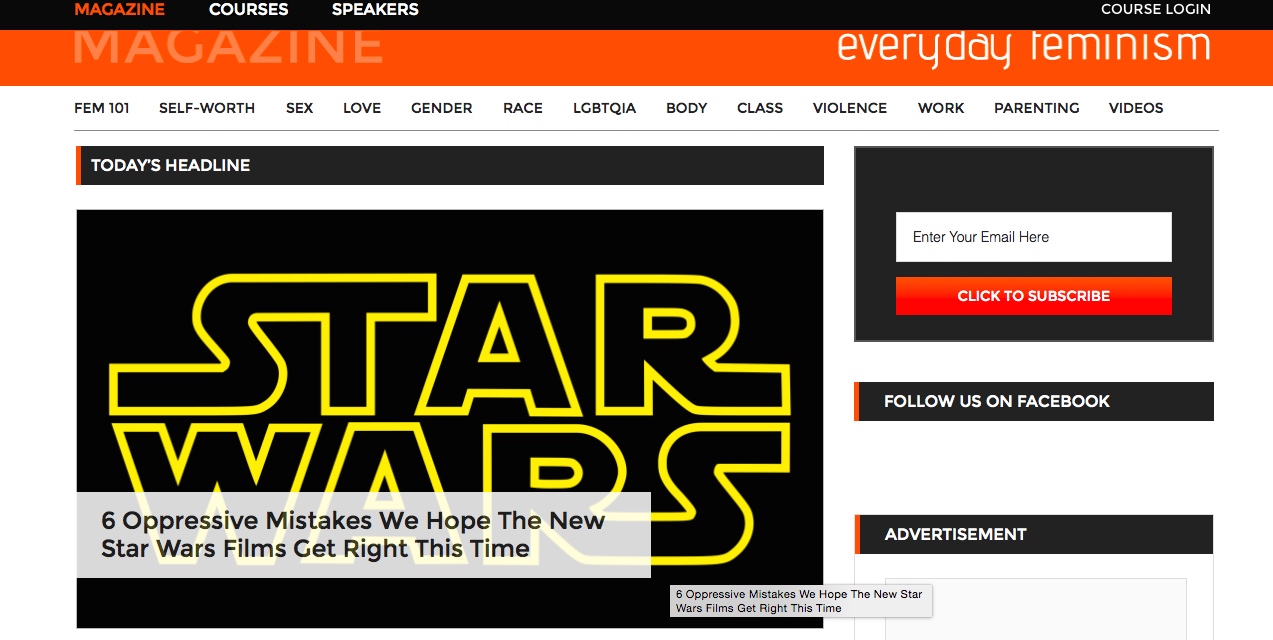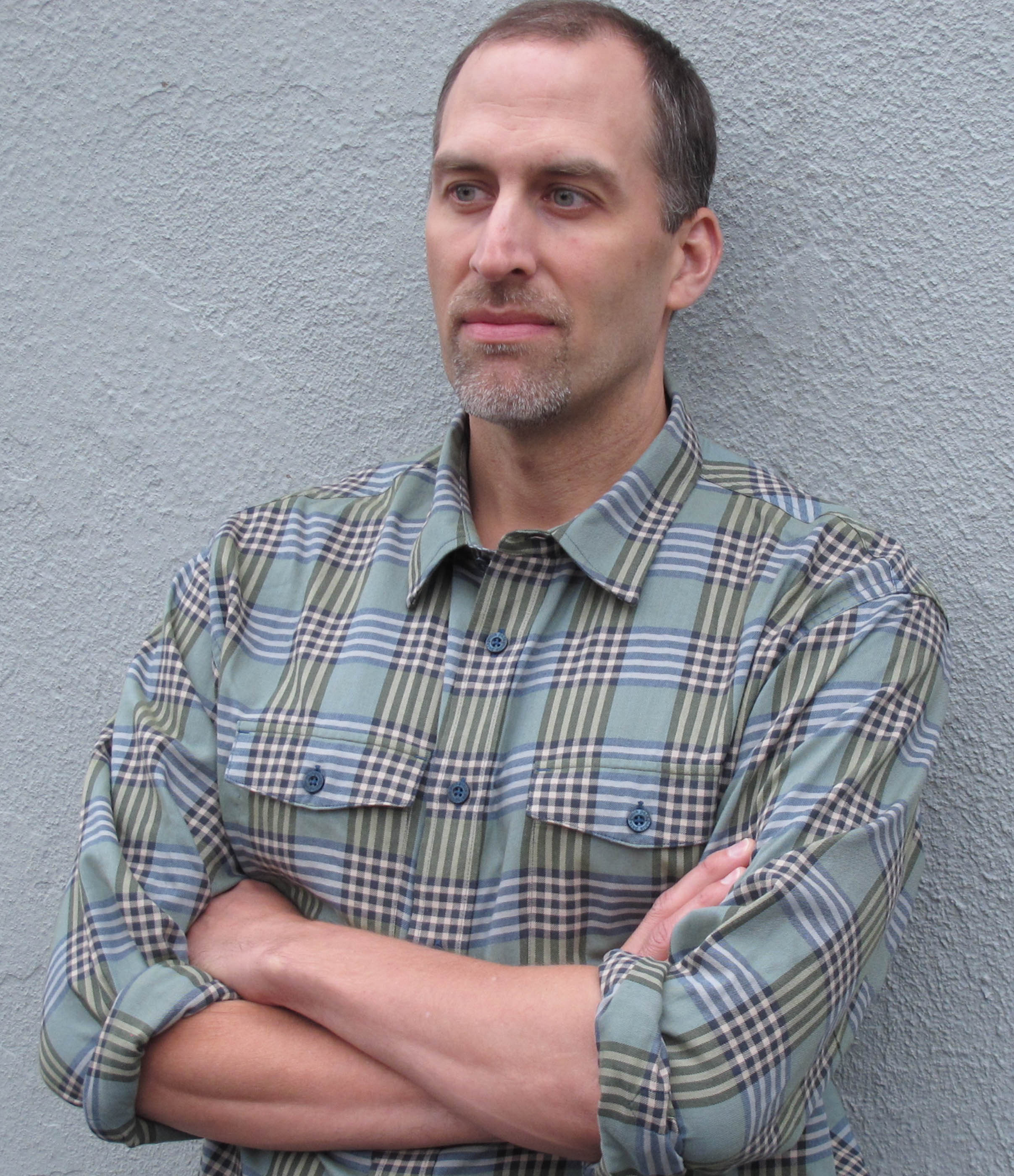My newest article for Everyday Feminism just posted.
My protracted conflict with Seattle Public Schools has prepared me to write this piece, as it will likely be a bit controversial to many readers. You don’t just apply a critical eye to films with perhaps the most dedicated fans in existence and expect to walk away unscathed. But the hope is not just to pick apart the first six movies but rather to demand a better seventh one, one we can all watch guilt-free.
6 Oppressive Mistakes We Hope The New Star Wars Films Get Right This Time
Hopefully, in addition to ire by gatekeepers of the status quo, it will inspire some meaningful dialogue.







Jon,
I think you really could be much harsher on these movies, and I say that as an ardent fan. Most of those complaints can be condensed into a single one about the diminished positive role that any non-white non-male plays within the series, as well as how commonly non-white and non-males show up as antagonists or comedic minstrel-esque side characters.
The non-heteronormative demographic is zero so that balanced out in a depressing sort of way, but I do not think we should continue to ask every character to present gender. Not only does this often require extraneous material to be added (Dumbledore had tons of pagetime and was heavily developed but even Rowling never managed to work it into the main text without it looking forced) but it also diminishes, in a way, the visibility of agender or asexual characters and tends to erase bisexuals out of any situation that does not cause drama and reinforce the negative stereotypes associated with them.
Lots of gendering is flying a flag to show what the sexuality of the character is. Leaving things ambiguous is more realistic, frankly, and allows gender to be relevant when gender is relevant–and not else–which is more helpful. People see gender as a major identity component in part because we require it to be part of the “name/rank/serial number” identification check, but why?
If there is a lot of relationship going on in the next movie then I would absolutely encourage them to show some non-heteronormative characters as well, in positive and non-contrasting (ie, not competition, just let them be characters without making them compete for additional drama) ways to show that your gender is part of you but it is not the you that that other people should be fixating on.
Maybe Leia was actually bi or asexual and that’s why it took her so long to warm up to Han’s boorish attempts. We don’t know, and unless Lucas pulls a Rowling and says she was, we won’t. I do think it’s kinda annoying that the difference between a gay icon and a generic agender fiction character is an author’s admission after the books are done.
I would also say, overall, the most egregious aspect of the characterization of everyone is that the most offensive racializing and female disempowerment come from the new movies, not the ones made back before I was even born. This is backsliding for no reason. While one can try to debate if Leia or Padme is a stronger symbol within the limited spectrum of “who kills the most people” that misses the fact that Padme is infantilized by her handlers and constrained both by role and by costume into some backwards vision of seductress madonna.
Leia, by comparison, got dressed up as a Slave and relatively promptly choked a car-sized gangster to death with her own chains before heading back. The only reason she was even in such a situation is that she took a break from leading a galactic rebellion against a tyrannous Empire to rescue friends in the guise of a male bounty hunter. Outside of the bikini fiasco her characterization was strong and the only time she cringed away from action was as fake made believable because she had just been shot.
There’s really no comparison.
My only real complaint with your post, however, is a concern that the entry about not believing in the melding of “violence and spirituality” is dangerously eurocentric, however. And that not realizing that the Jedi Temple, with the skybox seating it has, is really not that different from the palatial estates of other religious leaders, including the mountain-top temples of the Tibetan Buddhists who got mentioned.
Tibet was, afterall, once an Empire–even while buddhist–which invaded its neighbors and even took territory from local big dog China. Buddhism is also core to Kung Fu, which as an outgrowth of a meditative exercise, is precisely a melding of violence and spirituality. Martial Arts in general has a long history of placing the spiritual components at the core of the practice, and given how central the Samurai ethos and spirituality was to the creation of the Jedi (and Vader’s costume in specific) it is not surprising to see this in the Jedi.
The depiction of the Jedi in the prequels is, of course, tragic and terrible, but it is somewhat strange to say it is not conceivable that an organization of religious authorities would appoint themselves peacekeepers and impose themselves on others with the sword if necessary, all while calling themselves civilized from atop their high citadels appointed in learning, luxury, and safety.
Even from a strictly European perspective you only need to do a bit of digging to see how someone like Pope Juilius II, nicknamed The Warrior Pope and not as a metaphor for spiritual ruggedness, could be both literally the spiritual leader of a vast Empire and a commander who endorsed a robust foreign policy and sent troops against his enemies. This is the same pope that made such trouble for Henry VIII, leader of one of the more powerful nations on the planet at the time, and who battled (quite literally at times) with the Borgias. You do not get mentioned in The Prince by Machiavelli without good reason.
Fun fact, he also had the Sistine Chapel painted by Michelangelo.
I’m not saying this part was a terribly ignorant statement, but I think (especially within the context of Buddhism which has both a European loan-value and it’s own vast and individual expressions which do at times have violence or at least fighting as central to expression) it does feed a kind of “Enlightened Savage” perspective that some people have. It also seems to suggest a poor reading of history that diminishes the overall value of the post. It’s similar to the “wow, you are so articulate” well-meaning mistake that people use when referring to black people. Buddhists are not all quiet, peaceful, and devoid of worldly possessions.
I will say, despite how incorrect that section seemed, I am thrilled that nowadays we reject violence and spirituality as incompatible. That is progress. The real truth is that such a combination, along with status and wealth, is really pretty normal, both in the society from which the Jedi were copied and from the society that most of the Western production of Star Wars grew up in. Not even in a distant past, but recently and right now.
Frankly, since Tibet is the focus, we can even just look there. Until around 1960 or something Tibet was basically a monarchist theocracy with a relatively rigid caste system that included an Untouchables Caste (amongst which were smiths and gold-workers and fishermen, generally considered valuable members of the community elsewhere) and may have even included a small institution of slavery as well as the more commonly documented low-caste hereditary servants. Even feudalism tended to offer greater capacity for personal advancement than a caste system.
I realize this is a lot of picking on one single example raised, but I think it’s important not to reduce complex peoples into a chicken nugget concept of what we think they are, were, and are like. Saying that status and wealth, as well as violence, are not found in places like that is strange. Tibet was absolutely a place where political and spiritual authorities sat atop mountains and looked down at the other people, including the “untouchable” gold-smiths who worked in presumably lousy conditions to craft the immense gold buddhas and beautiful pieces of art which adorned those lofty Shangri-la temples.
Sounds like Tatooine to me.